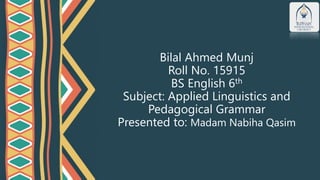
The Natural Approach .pptx
- 1. Bilal Ahmed Munj Roll No. 15915 BS English 6th Subject: Applied Linguistics and Pedagogical Grammar Presented to: Madam Nabiha Qasim
- 3. Contents • History & Background • Definition • Theories 1) The Acquisition-Learning hypothesis 2) The monitor hypothesis 3) The natural order hypothesis 4) The input hypothesis 5) The affective filter hypothesis • Design • The Syllabus • Teacher role in natural approach • Learner role in natural approach • Procedure of natural approach • Advantage / Disadvantages of natural approach • Conclusion
- 4. • It was developed and published as a book by Mr. Stephen Krashen & Mrs. Tracy Terrell in 1983. • Mr. Stephen Krashen is a famous linguist – Mrs. Tracy Terrell is an educational theorist and a professor at University of California. History & Background
- 5. • Natural Approach believes that adult can still acquire second languages. The ability of language acquisition does not disappear as we grow up. • Adults have LAD. Adults also acquire language by following the principles of Universal Grammar. • The different between adult and children acquisition skill is that adults have two things to follow when they learn foreign language: 1. Acquisition 2. Learning • But Children only acquire the language. • They consider their approaches as a Traditional method. Continue……
- 6. 1.The Acquisition-Learning hypothesis 2.The monitor hypothesis 3.The natural order hypothesis 4.The input hypothesis 5.The affective filter hypothesis Theories
- 7. The Acquisition / Learning Hypothesis
- 8. • The most basic steps of all in the Krashen's theory. • It's the most well known among linguists and language practitioners. • The learner has two ways of learning the second language, which are the acquired system and the learned system. The Acquisition / Learning Hypothesis
- 9. The Monitor Hypothesis The learning system performs the role of the “monitor” or the “editor”. Conscious learning can function only as monitor or editor that checks and repairs the output of the acquired system.
- 10. The Natural Order Hypothesis The acquisition of grammatical structures proceeds in a predictable order. Research is said to have shown that certain grammatical structures or morphemes are acquired before others in first language acquisition of English, and a similar natural order is found in second language acquisition. Errors are signs of naturalistic developmental processes, and during acquisition (but not during learning), similar developmental errors occur in learners no matter what their mother tongue is.
- 11. • It relates to acquisition and not to learning. • People acquire language best by understanding input. • The ability to speak fluently emerges independently in time. • If input is understood and there is enough of it, the necessary grammar is automatically provided. The Input Hypothesis
- 13. • When the learner’s emotional state can act as a filter that can prevent input from teaching the learner’s language acquisition device. -Filter is up= Negative emotional Factors and they won’t acquire language. -Filter is down= Learner will learn better. The Affective Filter Hypothesis
- 14. Objective • The natural approach is for beginners and designed to help them become intermediates. • Specific objectives depend upon learners needs and the skill and level being taught. Design
- 15. Krashen and Terrell approach course from two points of view: • First point of view 1. Basic personal communication skills: Oral (e.g., listening to announcements in public places) 2. Basic personal communication skills: written (e.g., reading and writing personal letters) 3. Academic learning skills: oral (e.g., listening to a lecture) 4. Academic learning skills: written (e.g., taking notes in class) • Second point of view: 1. The purpose of a language course will vary according to the needs of the students and their particular interests The Syllabus
- 16. Nadir Hussain Roll No. 16451 BS English 6th Next Presenter
- 17. • Teacher has three major roles in natural approach • Teacher is the primary source of providing comprehensible input, and he is responsible to make it understood by language acquirer by non-linguistic clues. • He/she is responsible for making a classroom atmosphere which is less stressful more engaging, low affective filters for language learning. • He/she is responsible for mix use of different classroom activities according to the competence level of learners. Teacher Roles in Natural Approach
- 18. • Language acquirers are the processors of input which is slight above their current language competence, and they are challenged by this input. I+1 • In the pre-production stage, students participate in language activities without having to respond in the target language. For example, they can act out physical commands, identify fellow students from teacher's description, point to pictures and so forth. • In early production stage, students respond to either-or questions, one word, or short phrases, fill in charts, and use fixed conversational patterns. • In the speech emergent phase, students involve themselves in role play, & games, contribute personal information and opinions, and participate in group problem solving activities. Learner Roles in Natural Approach
- 19. Procedure of natural Approach • Lessons in the natural approach focus on understanding messages in the foreign language, and place little or no importance on error correction, drilling or on conscious learning of grammar rules. They also emphasize learning of a wide vocabulary base over learning new grammatical structures.
- 20. Advantage of natural Approach • An effective way is creating leaner to be competence in using the target language communicatively.
- 21. • Time wasting • Not all teachers are proficient enough in target language Disadvantage of natural Approach
- 22. The Natural Approach rejects the formal grammatical organization of language to teach it. It is not used at a native level. It emphasizes comprehensible and meaningful practice activities, rather than production of grammatically perfect utterances and sentences. Conclusion
